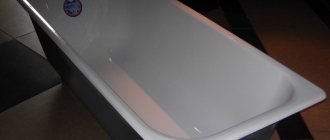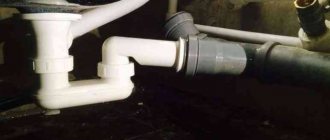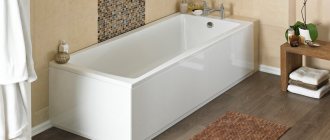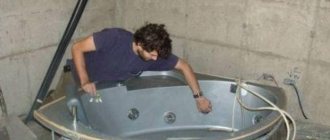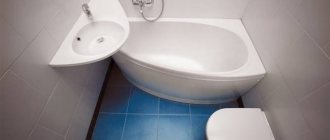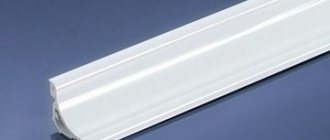Cast iron is the very first material from which bathtubs were made on an industrial scale.
Until now, they are popular among consumers due to their undeniable advantages .
What is the first association that comes to mind when you hear “cast iron bathtub”? That's right, it's very heavy. Heavy weight is a distinctive feature of products made from this material.
If you are planning to choose and buy a cast iron hot tub or, perhaps, on the contrary, get rid of it, would it be a good idea to know how much it weighs? We will talk about this in detail in the article.
Advantages and disadvantages of a cast iron bathtub
Plumbing manufacturers use new materials - acrylic, earthenware, marble, but cast iron continues to be in great demand; it is the leader in the plumbing market. Such baths, despite their conservative design, have many advantages.
Among them:
- Long service life. Cast iron products are 3-5 times superior to competitors in this parameter. Many apartments still have old bowls from Soviet times in good condition. Manufacturers claim a service life of 30 years, but according to statistics, such things last longer. There are restoration systems for cast iron bowls that extend their service life.
- Temperature preservation. Having heated up once, the bowl gives off heat for a long time, the water slowly cools down. In addition, this allows you to save resources.
- Strength. Cast iron is a hard metal, products made from it will not bend or change shape. Under the weight of water and the human body, the bathtub will not sag or deform when a heavy object falls into it.
- Stability and reliability. The bathtub is heavy, so it is difficult to tip it over when sitting on the side, or to move it from its place. The set includes supports that can withstand the entire weight. This provides additional safety - the bathtub stands firmly on the supports, and due to its large mass it is securely fixed to them.
- Noise insulation. The cast iron walls are thick - 5-7 mm, due to this the sound of water falling from the tap is absorbed.
- Anti-corrosion coating. The original appearance is preserved for a long time, and the enamel that covers the surface lies evenly and smoothly, which gives shine and gloss. It is applied in several layers, so you can wash your pets in the bath - claws will not harm the coating.
- Easy to care for. The smooth enamel surface does not retain dirt, so it is easy to care for. You can clean it with household chemicals that do not contain acid or large abrasive particles.
- There are models on the market with additional useful options - hydromassage, comfortable handles, anti-slip coating.
Disadvantages of cast iron models:
- Difficulty in transportation and installation. The bowls weigh at least 90 kilograms, so the help of loaders will be required.
- Warm-up required. You should pour water hotter than required for swimming, because part of the heat will be used to warm up the thick walls.
- High price. A product made of cast iron has a higher price than analogues made of acrylic, earthenware and other materials, but has a longer service life.
- Limited forms. The complexity of cast iron does not allow us to produce bowls of complex shapes, so the range is limited.
Results
If you intend to purchase a cast iron bathtub, you should first find out what the weight of the cast iron bathtub is. This parameter must be taken into account when installing equipment in multi-story buildings. If heavy plumbing does not create a special load on concrete floors, then with wooden beams the situation is different.
The modern market offers a huge selection of cast iron plumbing fixtures, so you can purchase a model of the appropriate size, shape and color. Despite the fact that significant weight is a disadvantage of the devices, they are practically indestructible. Therefore, a cast iron hot tub will serve you for many years.
Weight of Soviet baths
Cast iron bowls in the Soviet Union were made in several sizes; GOST established three main standard models:
- HF - enameled cast iron;
- VChM - modernized version;
- HFMO - modernized lightweight.
The material for cast iron bathtubs contains more carbon than steel, so the products are more fragile. Manufacturers are forced to make thick walls to support the load, which increases the final weight.
Length 150 cm
A common model in the USSR was a rectangular container 150x70 cm. The weight of such a product ranged from 98 (modernized version) to 102 kg (simple enameled). More comfortable options had a larger width, from 75 to 85 cm, weighing from 110 to 130 kg. The depth of all products is standard.
Length 170 cm
A longer bathtub weighed more, up to 110 kg with the same width of 70 cm. This model is more difficult to transport. The weight of wider baths was 120-145 kg.
Soviet cast iron bath.
How much does cast iron weigh or why is it so heavy?
A cast iron bathtub has been deservedly used for decades. Back in Soviet times, its use proved the reliability and durability of cast iron.
One of the disadvantages of such baths is their heavy weight. Cast iron is not a light alloy. Its density averages 7200 kg/m3. Compared to steel, this alloy contains more carbon, which makes it brittle.
Therefore, in order for the bathroom to be truly resistant to deformation, it is made with thick walls. The wall thickness of bathtubs from domestic manufacturers is 7-10 mm. This is what causes their heavy weight (from 80 kg).
This will probably seem untrue or incredible to you, but cast iron is lighter than steel. Steel has a higher density compared to cast iron - on average 7800 kg/m3.
Why are steel bathtubs lighter than cast iron bathtubs?
The wall thickness of steel bathtubs is half as thin (3-4 mm) as that of cast iron bathtubs - as a result, the total weight of the product is less.
Are you planning to change your bathtub and can’t choose a model? Our review contains sizes, prices and photos of cast iron bathtubs of both Russian and foreign production.
Our article will tell you what glass bath curtains are.
Modern bathtubs that combine all the advantages of a bathtub and a shower. Do you think such things exist? Yes, and examples in our article.
Weight of modern cast iron baths
Modern production has made the products lighter; now they weigh less than their Soviet counterparts. Technologies have made it possible to maintain strength while reducing wall thickness. Modern cast iron bathtubs are not subject to old standards, and GOST standards do not impose strict weight requirements. According to current standards, the minimum thickness of the bowl and the enamel coating layer is not regulated.
Russian 150 cm long
A modern bowl of standard dimensions 150x70 cm weighs about 90 kg. This option is well suited for installation in Soviet-era apartments where bathroom space is limited. The difference in weight with Soviet models is about 10 kg.
Length 170-180 cm
Thinner walls affected the final weight, which became 12-20 kg less than older models. The weight of modern cast iron bathtubs is in the range of 99-108 kg.
Length less than 150 cm, sessile
Cast iron models with a length of less than 150 cm are called “sedentary”; the width of such models is standard - 70 cm. It will be uncomfortable for a person of average height to take a bath, but such products are well suited for small bathrooms. The approximate weight of seated models is about 80 kg, foreign models are 8-12 kg less.
USSR sitz bath.
General information
When a consumer chooses a suitable model of plumbing fixtures, he is concerned not only with the dimensions, shape and aesthetic side of the issue, he should also take into account the weight of the cast iron bathtub. After all, the level of complexity of transporting plumbing fixtures and its immediate installation depends on this indicator.
Help: The weight of the Soviet cast-iron bathtub was so large that even two adults found it very difficult to handle such equipment. At that time, as a rule, models of standard sizes 150x70 cm were installed. In fact, this is a medium-sized bathtub, but it weighed at least 100 kg.
Today, manufacturing technologies for plumbing fixtures have changed greatly, so the weight of a cast-iron bathtub has decreased significantly. Of course, the difference cannot be called colossal, about 30-40 kg, but for one product this is a lot.
Comparison of weight of models from different manufacturers
An analysis of products from domestic and foreign manufacturers showed that imported sanitary ware is 15-30 kg lighter with equal length and width. This is due to the fact that many countries save water, so the depth of imported bowls does not exceed 35 cm. For Russian models, this figure is greater - 45-60 cm.
Chinese and European models are produced with thinner walls; instead of 8-10 mm, they are made of 5 mm. There are thinner options, which affects the characteristics of the entire product and reduces its service life. Chinese manufacturers skimp on the enamel layer, and this negatively affects the quality of the coating and resistance to mechanical damage. Such methods make it possible to reduce the final weight of the product, but other characteristics deteriorate.
The weight of a 170x70 cm Italian bathtub is 78 kg. Among European manufacturers of plumbing fixtures, Castalia stands out; it produces a 170x70 cm model that weighs 120 kg, which is heavier than similar domestic products.
Tabular data
How much an old cast iron bathtub weighs depends on several factors:
- Tank depth;
- Product wall thickness;
- The length and width of the font itself.
However, the weight of the device may vary depending on the manufacturer. After all, some manufacturers deliberately reduce the thickness of the walls of the product, then the bathtub becomes lighter.
The weight of an old cast iron bathtub of traditional sizes (170×70) can range from 90-95 kg to 100-120 kg. In the table you can see the approximate weight of products of the most common sizes:
Steel bath weight
Metal baths are often also called iron baths. Steel and cast iron are alloys of iron and carbon; the materials differ in the percentage of these components, which determines the difference in properties.
Steel bath 180×80.
Steel baths are about 5 times lighter than cast iron, although steel is a heavier material. Due to the greater strength of the wall, steel products do not need to be made thick - the standard size is 2-3 mm. If they are thinner, there is a possibility of their deformation under load.
Weight depends on the configuration and dimensions of the bowl. The seated model 90x60 cm weighs up to 15 kg, the standard 150x70 - about 20 kg. The long version from 170 cm weighs more than 30 kg. If a steel bowl weighs too little, this is an indicator of poor quality material. Such products will not withstand long-term use; they will give off heat too quickly and become deformed.
Will the ceiling hold up?
The first thing that seems especially important when analyzing this issue is whether special measures are required to strengthen the floors when installing a cast iron bathtub? How many additional supports should be placed under the longitudinal crossbars? Such reflections seem especially relevant for amateur builders who are building a house with wooden floors without professional calculations from a specialist designer. How much does a container filled with water weigh along with a person? The maximum value is about 700 kg. After calculating the point load on the floor, an approximate figure of 320 kg per 1 m2 is obtained. This value is quite acceptable for reinforced concrete monolithic and prefabricated floors that have a sufficient safety margin.
In the case of frame-type ceilings made of wooden load-bearing elements, you should think about reinforcement. Typically, such measures are carried out in conjunction with waterproofing work necessary for bathroom equipment.
What load can it withstand?
If done well, an acrylic bathtub 170 cm long can easily withstand a weight of half a ton. Therefore, if you want to collect 100 liters of water (that’s 100 kg), and then climb in yourself with a weight of 150 kg (this is all hypothetical), you will still have a decent safety margin of 250 kg.
Such serious preparation is possible thanks to manufacturing technology: acrylic must have a base (fiberglass and resistant plastics are used for this), on which acrylic is laid in layers. Since the main load in the bathtub falls on the bottom, it is strengthened with additional layers of base material, acrylic and a special base.
What to do with the installation
This process consists of several main steps:
- The bathtub must be brought into the room before installation begins.
- The leg parts are secured using brackets; you will also need a set of bolts. The main thing is to turn the bathtub over in advance so that the lower part is at the top.
- Siphon and drain-overflow designs - installation of fittings is carried out at the next stage. There should be an inlet in the bottom hole. At the lower end of the tee it is necessary to screw in a flanged pipe. It is then inserted into the socket of the siphon.
- It is not necessary to tilt the bathtub itself towards the drain hole. But you need to use a level to correctly calculate the levels for the slope. To drain most efficiently, you can adjust the part where the support is located. In addition, this will help make the bath itself more stable.
- It is necessary to treat with special sealants the places where the bathtub is adjacent to the wall. The main thing is that it fits against the wall as tightly as possible.
- After this, the parts of the sewer and drainage fittings are connected together. A water shutter mechanism is installed on the outlet valve. It is to this part that we then attach the outlet pipe.
It is important to pay special attention to grounding. To do this, one end of the wire is connected to a special lug located on the surface of the housing, and the other to a PE bus or to a potential equalization system. At the last stage, the bathtub must be filled with water.
This will allow you to check how strong the connections are. Then you can remove the drain plug and inspect each joint.
Before the operation process begins, it is recommended to fill the structure with 5-7 liters of cold water and then drain it. And only after this you can switch to hot water as usual.
It is recommended to carefully examine the surface of the bathtub not only during purchase, but also after delivery. After all, at this moment you can still refuse the damaged product and ask for a replacement if the need arises.
Chips of enamel and cracks on the surface are unacceptable. Fasteners, legs and the bathtub itself are mandatory elements in any set. Before paying, be sure to check how complete the package has been sent.
For some, the heavy weight of cast iron bathtubs can be an advantage, but for others a serious disadvantage. It all depends on the specific wishes, preferences and requirements of each buyer.
If you don’t take them into account in advance, you may end up in serious trouble later. After all, it is very difficult to replace a bathtub; it is bought for at least a few years.
Of course, this issue can be resolved, but then additional costs cannot be avoided. It is better to take into account all the factors in advance, then no questions or problems will arise. And the bathroom will delight buyers for a very long time.
Sellers are always happy to provide consultations and talk about the features of a particular product to make the choice easier for their customers. They are ready to offer further maintenance if necessary.
Source: https://zonavannoi.ru/santehnika/wanna/skolko-vesit-chugunnaya.html
What does this affect?
The lightness of acrylic is its advantage. However, any lightweight structure with a slight shift in the center of gravity can easily tip over. It is this prospect that frightens our compatriots, forcing them to choose unaffordable samples made of steel and cast iron.
This is interesting: Acrylic bathtub with hydromassage
In addition, the weight of a standard acrylic bathtub is an indicator of quality. Too light containers with the same weightless price are a cunning marketing ploy. Most likely, the thickness of the material is small, which means it is unlikely to withstand a large or even standard load.
If you are going to buy a non-standard acrylic bathtub or have it custom-made, then inquire about the weight of competitive analogues. The mass of similar samples with the same set of functions or volumetric parameters cannot differ much.
The weight of an acrylic bathtub can affect the difficulty of delivery, lifting to the apartment and its installation. It is logical that simple models can be moved by 1 person, and in order to bring the bathtub into the room you will need a maximum of 1 assistant. The situation can become more complicated with non-standard parameters. Although the buyer is unlikely to worry about such a question: most likely it will be an order, which means the budget has already been allocated for the cost and installation services.
The stability of acrylic is calculated and verified. Standard samples are not much different, in addition, there are many options to add additional reliability in the form of stands and podiums. In this case, the chances of an acrylic bathtub overturning are not much higher than those of a heavy cast iron bathtub. Moving the latter from place to place (with a weight of about 150 kg) is difficult for two people even for strong men, and doing this with a large group is simply inconvenient.
Minuses
The thickness of bathroom products is a very important parameter. After installation, the process of using it in everyday life begins, and here, in addition to the owner’s weight, time will be merciless. Acrylic bathtubs cannot boast of an “eternal” service life; they will last for several decades.
But you can make corrections to the coating and continue to use acrylic products. But possible deformation over time is a real threat. It won’t appear soon, so you can enjoy your bath for the next 10 years.
This bath has a significant drawback in the form of poor tolerance to high temperatures. There is no need to put almost boiling water into it. Again, acrylic can simply “lead” from such a neglectful attitude.
Due to its small thickness, the water cools quickly, but long periods of water procedures are not for everyone.
To avoid failure in your choice, you need to remember simple rules:
- Trust the professionals. Low prices from market newcomers can lead to trouble. Ask for certificates of quality and product conformity, compare the specified characteristics with the words of the seller. If they disagree, then look for another store. The market for such services is huge.
- Pay attention to the top layer of acrylic: its recommended thickness is 4-8 mm.
- Cast acrylic will last longer.
- Unpleasant chemical odors are evidence of poor quality. Trust your nose.
- Models with steep and straight outer walls are, by design, more stable than spherical and asymmetrical ones.
When you find your perfect acrylic bathtub, you'll know how to check its quality. Happy shopping!
